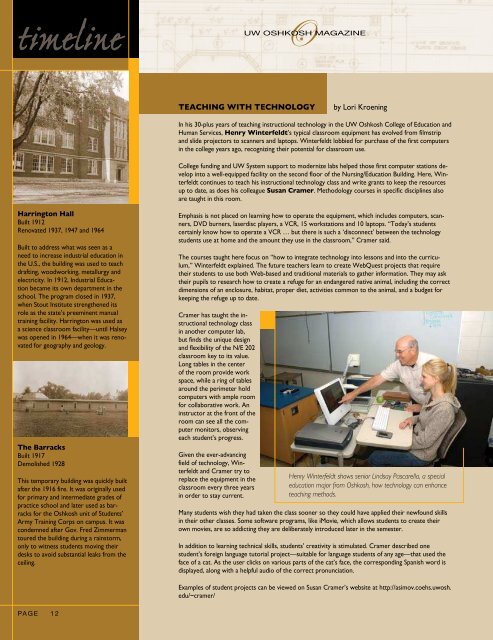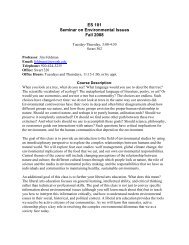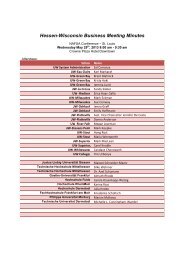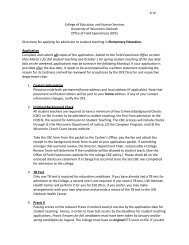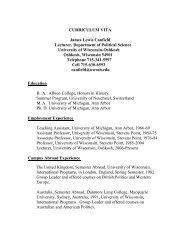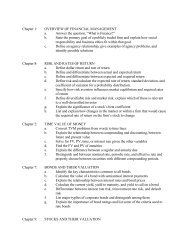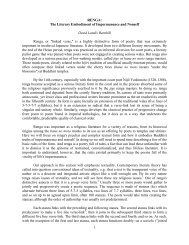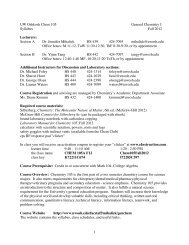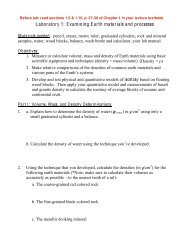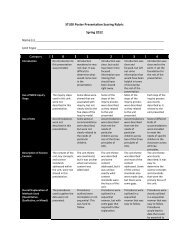Fall 05 (pdf) - University of Wisconsin Oshkosh
Fall 05 (pdf) - University of Wisconsin Oshkosh
Fall 05 (pdf) - University of Wisconsin Oshkosh
Create successful ePaper yourself
Turn your PDF publications into a flip-book with our unique Google optimized e-Paper software.
timeline<br />
O<br />
UW OSHKOSH MAGAZINE<br />
O<br />
UW OSHKOSH MAGAZINE<br />
timeline<br />
Harrington Hall<br />
Built 1912<br />
Renovated 1937, 1947 and 1964<br />
Built to address what was seen as a<br />
need to increase industrial education in<br />
the U.S., the building was used to teach<br />
drafting, woodworking, metallurgy and<br />
electricity. In 1912, Industrial Education<br />
became its own department in the<br />
school. The program closed in 1937,<br />
when Stout Institute strengthened its<br />
role as the state’s preeminent manual<br />
training facility. Harrington was used as<br />
a science classroom facility—until Halsey<br />
was opened in 1964—when it was renovated<br />
for geography and geology.<br />
The Barracks<br />
Built 1917<br />
Demolished 1928<br />
This temporary building was quickly built<br />
after the 1916 fire. It was originally used<br />
for primary and intermediate grades <strong>of</strong><br />
practice school and later used as barracks<br />
for the <strong>Oshkosh</strong> unit <strong>of</strong> Students’<br />
Army Training Corps on campus. It was<br />
condemned after Gov. Fred Zimmerman<br />
toured the building during a rainstorm,<br />
only to witness students moving their<br />
desks to avoid substantial leaks from the<br />
ceiling.<br />
PA G E 1 2<br />
Teaching with Technology<br />
by Lori Kroening<br />
In his 30-plus years <strong>of</strong> teaching instructional technology in the UW <strong>Oshkosh</strong> College <strong>of</strong> Education and<br />
Human Services, Henry Winterfeldt’s typical classroom equipment has evolved from filmstrip<br />
and slide projectors to scanners and laptops. Winterfeldt lobbied for purchase <strong>of</strong> the first computers<br />
in the college years ago, recognizing their potential for classroom use.<br />
College funding and UW System support to modernize labs helped those first computer stations develop<br />
into a well-equipped facility on the second floor <strong>of</strong> the Nursing/Education Building. Here, Winterfeldt<br />
continues to teach his instructional technology class and write grants to keep the resources<br />
up to date, as does his colleague Susan Cramer. Methodology courses in specific disciplines also<br />
are taught in this room.<br />
Emphasis is not placed on learning how to operate the equipment, which includes computers, scanners,<br />
DVD burners, laserdisc players, a VCR, 15 workstations and 10 laptops. “Today’s students<br />
certainly know how to operate a VCR … but there is such a ‘disconnect’ between the technology<br />
students use at home and the amount they use in the classroom,” Cramer said.<br />
The courses taught here focus on “how to integrate technology into lessons and into the curriculum,”<br />
Winterfeldt explained. The future teachers learn to create WebQuest projects that require<br />
their students to use both Web-based and traditional materials to gather information. They may ask<br />
their pupils to research how to create a refuge for an endangered native animal, including the correct<br />
dimensions <strong>of</strong> an enclosure, habitat, proper diet, activities common to the animal, and a budget for<br />
keeping the refuge up to date.<br />
Cramer has taught the instructional<br />
technology class<br />
in another computer lab,<br />
but finds the unique design<br />
and flexibility <strong>of</strong> the N/E 202<br />
classroom key to its value.<br />
Long tables in the center<br />
<strong>of</strong> the room provide work<br />
space, while a ring <strong>of</strong> tables<br />
around the perimeter hold<br />
computers with ample room<br />
for collaborative work. An<br />
instructor at the front <strong>of</strong> the<br />
room can see all the computer<br />
monitors, observing<br />
each student’s progress.<br />
Given the ever-advancing<br />
field <strong>of</strong> technology, Winterfeldt<br />
and Cramer try to<br />
replace the equipment in the<br />
classroom every three years<br />
in order to stay current.<br />
Henry Winterfeldt shows senior Lindsay Pascarella, a special<br />
education major from <strong>Oshkosh</strong>, how technology can enhance<br />
teaching methods.<br />
Many students wish they had taken the class sooner so they could have applied their newfound skills<br />
in their other classes. Some s<strong>of</strong>tware programs, like iMovie, which allows students to create their<br />
own movies, are so addicting they are deliberately introduced later in the semester.<br />
In addition to learning technical skills, students’ creativity is stimulated. Cramer described one<br />
student’s foreign language tutorial project—suitable for language students <strong>of</strong> any age—that used the<br />
face <strong>of</strong> a cat. As the user clicks on various parts <strong>of</strong> the cat’s face, the corresponding Spanish word is<br />
displayed, along with a helpful audio <strong>of</strong> the correct pronunciation.<br />
Examples <strong>of</strong> student projects can be viewed on Susan Cramer’s website at http://asimov.coehs.uwosh.<br />
edu/~cramer/<br />
and safety, like the sprinklers<br />
and elevators installed in the<br />
high-rise residence halls, Gruenhagen<br />
and Scott.<br />
“These jobs are not as exciting as a<br />
brand-new building, but the upgrades<br />
are necessary, regardless,” Arndt said.<br />
A driving force in long-range<br />
facility planning is accommodating<br />
the needs <strong>of</strong> contemporary students.<br />
When their parents went to college,<br />
they counted themselves fortunate if<br />
they had an electric<br />
typewriter; word<br />
processors, if they<br />
were available at all,<br />
were largely located<br />
in a few scattered<br />
campus computer<br />
labs. Modern<br />
students are raised<br />
to be wired every<br />
moment <strong>of</strong> the day<br />
with cell phones,<br />
personal digital<br />
assistants, iPods<br />
and laptops. The<br />
days have come<br />
when not only do<br />
incoming freshmen<br />
have to adapt to<br />
life at college, the<br />
university needs to<br />
address the lives <strong>of</strong><br />
those freshmen and<br />
the student body as<br />
a whole.<br />
The problem does not end with<br />
meeting students’ needs outside the<br />
classroom. The campus also strives to<br />
address curriculum-driven changes, too.<br />
When athletic training became<br />
a major in 2002, Kolf Sports Center<br />
was renovated, specifically designed<br />
to provide state-<strong>of</strong>-the-art facilities<br />
for students studying in the program.<br />
While UW <strong>Oshkosh</strong> had <strong>of</strong>fered<br />
a minor in athletic training since<br />
1977, more stringent requirements to<br />
become involved in this allied health<br />
field required stepped up curriculum<br />
to become an accredited program,<br />
preparing our students to pass the<br />
board-certified exam necessary to get<br />
employment.<br />
Student Grace McMurtrie buys a<br />
cappuccino from Mi Taza To Go,<br />
Clow’s “grab and go” café. Convenience<br />
and lifestyle are considered in building<br />
expenditures, and UW <strong>Oshkosh</strong><br />
administration works to cater to<br />
changing student needs.<br />
Upgrading the space created<br />
a facility designed to support the<br />
major. And the top-notch facility has<br />
increased the attention—and enrollment—<strong>of</strong><br />
well-qualified, high school<br />
and transfer students across the state.<br />
The major, with coursework<br />
that focuses on human anatomy and<br />
physiology, attracts these ambitious<br />
students. Their presence in general<br />
education classes affects the motivation<br />
and work quality <strong>of</strong> their peers.<br />
By raising the bar<br />
<strong>of</strong> achievement in<br />
the classroom, the<br />
athletic training<br />
majors create a<br />
domino effect <strong>of</strong><br />
excellence.<br />
“The enrollment<br />
<strong>of</strong> first-year<br />
majors has doubled<br />
for our program,”<br />
said Hal Strough,<br />
director <strong>of</strong> athletic<br />
training education.<br />
“Most visiting<br />
students, parents<br />
and other athletic<br />
teams specifically<br />
mention the<br />
facility as firstrate.<br />
I’ve seen the<br />
quality <strong>of</strong> students<br />
improve each year<br />
with regards to<br />
their ACT scores,<br />
grade-point averages, life experiences<br />
and desire to be at UW <strong>Oshkosh</strong><br />
before other schools.”<br />
The new facility <strong>of</strong>fers clinical<br />
space and <strong>of</strong>fices that are located near<br />
each other, a major concern for the<br />
faculty and students in the program.<br />
Strough said that the facility has<br />
simplified his job considerably. He can<br />
recruit potential majors more easily<br />
and give them the proper attention<br />
when they are enrolled in the program.<br />
Enrollment is at more than 100<br />
students.<br />
“Facilities are a significant factor<br />
in a program like ours: Our facility<br />
conveys that students will get a quality<br />
experience,” Strough said.<br />
Dempsey Hall<br />
Built in three sections:<br />
1917, 1918 and 1969.<br />
Dempsey was built after the 1916 fire.<br />
The frontage seen along Algoma Boulevard<br />
was the first section built—the<br />
foundation apparently was in place<br />
prior to the fire—for the science and<br />
administration wing. The second wing<br />
was the library wing. The war effort,<br />
which banned state building construction<br />
unless it supported the war, may have<br />
delayed the final construction phase for<br />
the northeast part <strong>of</strong> the building.<br />
1928 <strong>Oshkosh</strong> State<br />
Teachers College<br />
Swart Hall<br />
Built 1926–1928<br />
Renovated 1967 and 1990<br />
Built as a practice school and theater, the<br />
building worked to remedy the decaying<br />
classroom facilities on campus. Amid<br />
controversy <strong>of</strong> too few funds available<br />
to properly heat and furnish the building,<br />
it was finally opened as a state-<strong>of</strong>-theart<br />
facility—noted as one <strong>of</strong> the top<br />
six training schools in the U. S. The<br />
building served as home to more than<br />
1,000 Army Air Corps recruits between<br />
1942-1943.<br />
PA G E 1 3


